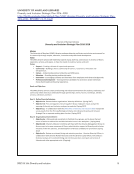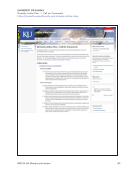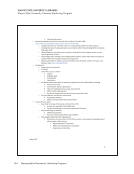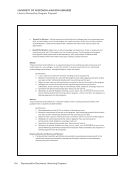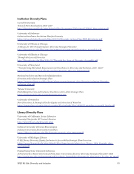48 Survey Results: Survey Questions and Responses
Substantial increase with in-house programming, including training workshops, exhibits, etc.
Increased collaboration with university Office of Diversity and Inclusion increased communication of
development opportunities available elsewhere in university (lectures, workshops, etc.)
The dean’s involvement with the Diversity Committee signified a greater importance to the effort. We
have embedded diversity into the overall strategic plan, making sure we look at every initiative from a
diversity perspective.
The Diversity Committee has a clear purpose and greater visibility but still needs to conduct training
and offer programs to improve this area.
The Libraries’ Diversity Committee has become much more active, going from offering a few events
a year to now offering monthly diversity-related programming. The programming offered by our
Director of Program Planning and Outreach has had an increased focus on issues relating to diversity
and inclusion.
The library has expanded collaborations, community engagement, and partnerships.
The library has modified a position that was inside HR and focused on development into a Diversity &
Inclusion Specialist position that reports directly to the dean.
The library’s interest and emphasis in promoting diversity and inclusion is unchanged. The university is
placing more emphasis on diversity and inclusion in its HR practices.
The programs and plans of the Diversity Committee have changed with the new membership roles.
Younger staff have joined and focus has shifted to unconscious bias µagressions.
The quantity and depth of diversity activities and training has increased in the past five years, including
numbers of library staff engaged at various levels.
The required diversity preference was added in 2014.
There has been a greater focus on ensuring that diversity and inclusion is woven into the fabric of all we
do and less as stand-alone initiatives.
They have not changed much in the past five years, but I anticipate that there will be change within the
next year or so.
This has become an area of greater importance over the last five years, culminating in the last year with
the creation of a library Diversity Committee.
This is the first year of our Diversity and Inclusion working group, so it is very early to appreciate
results. I think our results will be more significant a year or two from now. We have developed a draft
Diversity, Inclusion, and Equity statement to align the Libraries to the university’s statement. We hope
to socialize these ideas and include diversity and inclusion as prominent values in our values statement.
University-wide programs have expanded in response to changing legislation, the university’s mission,
and strategic priorities.
We administered the ClimateQUAL survey over a three-week period spring 2015. This has provided us
with baseline data to help us evaluate many aspects of the workplace related to inclusion and diversity.
It has helped us begin to think more strategically about these issues and to begin to develop plans.
We are doing fewer programs with more focused efforts on microaggressions, implicit bias, creating
a welcoming and inclusive environment, communication, and conflict management training for
supervisors and leaders.
We are now offering two minority fellow positions, which are 2-year term positions. Also shifting our
focus on more inclusion rather than just diversity. We are now offering a variety of training, i.e., Trans
101, Safer Places, DBL Inclusion, etc.
Substantial increase with in-house programming, including training workshops, exhibits, etc.
Increased collaboration with university Office of Diversity and Inclusion increased communication of
development opportunities available elsewhere in university (lectures, workshops, etc.)
The dean’s involvement with the Diversity Committee signified a greater importance to the effort. We
have embedded diversity into the overall strategic plan, making sure we look at every initiative from a
diversity perspective.
The Diversity Committee has a clear purpose and greater visibility but still needs to conduct training
and offer programs to improve this area.
The Libraries’ Diversity Committee has become much more active, going from offering a few events
a year to now offering monthly diversity-related programming. The programming offered by our
Director of Program Planning and Outreach has had an increased focus on issues relating to diversity
and inclusion.
The library has expanded collaborations, community engagement, and partnerships.
The library has modified a position that was inside HR and focused on development into a Diversity &
Inclusion Specialist position that reports directly to the dean.
The library’s interest and emphasis in promoting diversity and inclusion is unchanged. The university is
placing more emphasis on diversity and inclusion in its HR practices.
The programs and plans of the Diversity Committee have changed with the new membership roles.
Younger staff have joined and focus has shifted to unconscious bias µagressions.
The quantity and depth of diversity activities and training has increased in the past five years, including
numbers of library staff engaged at various levels.
The required diversity preference was added in 2014.
There has been a greater focus on ensuring that diversity and inclusion is woven into the fabric of all we
do and less as stand-alone initiatives.
They have not changed much in the past five years, but I anticipate that there will be change within the
next year or so.
This has become an area of greater importance over the last five years, culminating in the last year with
the creation of a library Diversity Committee.
This is the first year of our Diversity and Inclusion working group, so it is very early to appreciate
results. I think our results will be more significant a year or two from now. We have developed a draft
Diversity, Inclusion, and Equity statement to align the Libraries to the university’s statement. We hope
to socialize these ideas and include diversity and inclusion as prominent values in our values statement.
University-wide programs have expanded in response to changing legislation, the university’s mission,
and strategic priorities.
We administered the ClimateQUAL survey over a three-week period spring 2015. This has provided us
with baseline data to help us evaluate many aspects of the workplace related to inclusion and diversity.
It has helped us begin to think more strategically about these issues and to begin to develop plans.
We are doing fewer programs with more focused efforts on microaggressions, implicit bias, creating
a welcoming and inclusive environment, communication, and conflict management training for
supervisors and leaders.
We are now offering two minority fellow positions, which are 2-year term positions. Also shifting our
focus on more inclusion rather than just diversity. We are now offering a variety of training, i.e., Trans
101, Safer Places, DBL Inclusion, etc.


















































































